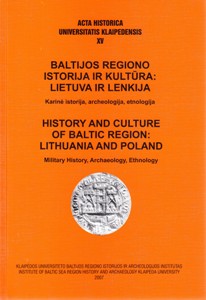Volume 15 (2007): Baltijos regiono istorija ir kultūra: Lietuva ir Lenkija. Karinė istorija, archeologija, etnologija = History and Culture of Baltic Region: Lithuania and Poland. Military History, Archaeology, Ethnology, December 2007

Order by:
Pub. online: 10 Dec 2007
Type: Article
 Open Access
Open Access
Journal:
Acta Historica Universitatis Klaipedensis
Volume 15 (2007): Baltijos regiono istorija ir kultūra: Lietuva ir Lenkija. Karinė istorija, archeologija, etnologija = History and Culture of Baltic Region: Lithuania and Poland. Military History, Archaeology, Ethnology, pp. 205–215
Abstract
Pub. online: 10 Dec 2007
Type: Article
 Open Access
Open Access
Journal:
Acta Historica Universitatis Klaipedensis
Volume 15 (2007): Baltijos regiono istorija ir kultūra: Lietuva ir Lenkija. Karinė istorija, archeologija, etnologija = History and Culture of Baltic Region: Lithuania and Poland. Military History, Archaeology, Ethnology, pp. 217–225
Abstract
Pub. online: 10 Dec 2007
Type: Article
 Open Access
Open Access
Journal:
Acta Historica Universitatis Klaipedensis
Volume 15 (2007): Baltijos regiono istorija ir kultūra: Lietuva ir Lenkija. Karinė istorija, archeologija, etnologija = History and Culture of Baltic Region: Lithuania and Poland. Military History, Archaeology, Ethnology, pp. 227–240
Abstract
Pub. online: 10 Dec 2007
Type: Article
 Open Access
Open Access
Journal:
Acta Historica Universitatis Klaipedensis
Volume 15 (2007): Baltijos regiono istorija ir kultūra: Lietuva ir Lenkija. Karinė istorija, archeologija, etnologija = History and Culture of Baltic Region: Lithuania and Poland. Military History, Archaeology, Ethnology, pp. 241–252
Abstract
Pub. online: 10 Dec 2007
Type: Article
 Open Access
Open Access
Journal:
Acta Historica Universitatis Klaipedensis
Volume 15 (2007): Baltijos regiono istorija ir kultūra: Lietuva ir Lenkija. Karinė istorija, archeologija, etnologija = History and Culture of Baltic Region: Lithuania and Poland. Military History, Archaeology, Ethnology, pp. 253–262
Abstract
Pub. online: 10 Dec 2007
Type: Book Review
 Open Access
Open Access
Journal:
Acta Historica Universitatis Klaipedensis
Volume 15 (2007): Baltijos regiono istorija ir kultūra: Lietuva ir Lenkija. Karinė istorija, archeologija, etnologija = History and Culture of Baltic Region: Lithuania and Poland. Military History, Archaeology, Ethnology, pp. 263–264
Pub. online: 10 Dec 2007
Type: Book Review
 Open Access
Open Access
Journal:
Acta Historica Universitatis Klaipedensis
Volume 15 (2007): Baltijos regiono istorija ir kultūra: Lietuva ir Lenkija. Karinė istorija, archeologija, etnologija = History and Culture of Baltic Region: Lithuania and Poland. Military History, Archaeology, Ethnology, pp. 265–266
Pub. online: 10 Dec 2007
Type: Book Review
 Open Access
Open Access
Journal:
Acta Historica Universitatis Klaipedensis
Volume 15 (2007): Baltijos regiono istorija ir kultūra: Lietuva ir Lenkija. Karinė istorija, archeologija, etnologija = History and Culture of Baltic Region: Lithuania and Poland. Military History, Archaeology, Ethnology, pp. 267–268
Pub. online: 10 Dec 2007
Type: Discussion
 Open Access
Open Access
Journal:
Acta Historica Universitatis Klaipedensis
Volume 15 (2007): Baltijos regiono istorija ir kultūra: Lietuva ir Lenkija. Karinė istorija, archeologija, etnologija = History and Culture of Baltic Region: Lithuania and Poland. Military History, Archaeology, Ethnology, pp. 269–270
Pub. online: 10 Dec 2007
Type: Discussion
 Open Access
Open Access
Journal:
Acta Historica Universitatis Klaipedensis
Volume 15 (2007): Baltijos regiono istorija ir kultūra: Lietuva ir Lenkija. Karinė istorija, archeologija, etnologija = History and Culture of Baltic Region: Lithuania and Poland. Military History, Archaeology, Ethnology, pp. 271–272